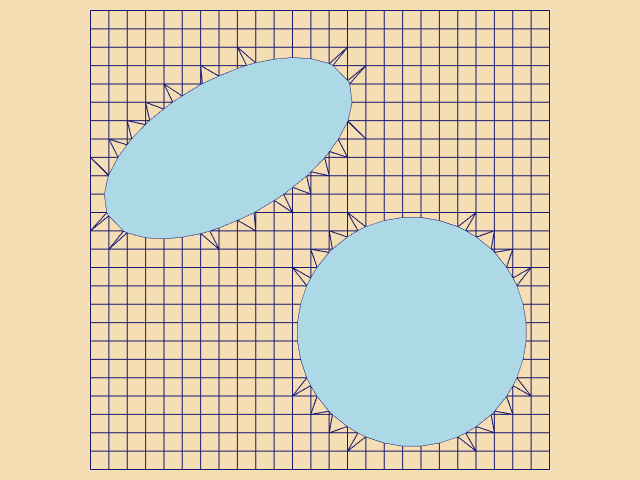ClipSphereCylinder
vtk-examples/Cxx/VisualizationAlgorithms/ClipSphereCylinder
Description¶
Clipping is implemented in vtkClipPolyData . Each polygonal data primitive implements the operation in its Clip() method using case tables. vtkClipPolyData has methods to control whether an implicit function provides the scalar data or whether the dataset’s scalar data will be used. ComputeScalarDataOn() uses the implicit function and ComputeScalarDataOff() uses the dataset’s scalar data. Two output polygonal datasets are produced. These are accessed with GetOutput() and GetClippedOutput() methods. GetOutput() returns the polygonal data that is “inside” the clipping region while GetClippedOutput() returns polygonal data that is “outside” the region. (Note that GenerateClippedOutputOn() must be enabled if you are to get the clipped output.) The meaning of inside and outside can be reversed using the InsideOutOn().
This example shows a plane of quadrilaterals clipped with a boolean implicit function.
Info
See Figure 9-48 in Chapter 9 The VTK Textbook.
Other languages
See (Python)
Question
If you have a question about this example, please use the VTK Discourse Forum
Code¶
ClipSphereCylinder.cxx
#include <vtkActor.h>
#include <vtkCamera.h>
#include <vtkClipPolyData.h>
#include <vtkCylinder.h>
#include <vtkImplicitBoolean.h>
#include <vtkNamedColors.h>
#include <vtkNew.h>
#include <vtkPlaneSource.h>
#include <vtkPolyDataMapper.h>
#include <vtkProperty.h>
#include <vtkRenderWindow.h>
#include <vtkRenderWindowInteractor.h>
#include <vtkRenderer.h>
#include <vtkSphere.h>
#include <vtkTransform.h>
int main(int, char*[])
{
// Demonstrate the use of clipping on polygonal data
//
// create pipeline
//
vtkNew<vtkNamedColors> colors;
vtkNew<vtkPlaneSource> plane;
plane->SetXResolution(25);
plane->SetYResolution(25);
plane->SetOrigin(-1, -1, 0);
plane->SetPoint1(1, -1, 0);
plane->SetPoint2(-1, 1, 0);
vtkNew<vtkTransform> transformSphere;
transformSphere->Identity();
transformSphere->Translate(.4, -.4, 0);
transformSphere->Inverse();
vtkNew<vtkSphere> sphere;
sphere->SetTransform(transformSphere);
sphere->SetRadius(.5);
vtkNew<vtkTransform> transformCylinder;
transformCylinder->Identity();
transformCylinder->Translate(-.4, .4, 0);
transformCylinder->RotateZ(30);
transformCylinder->RotateY(60);
transformCylinder->RotateX(90);
transformCylinder->Inverse();
vtkNew<vtkCylinder> cylinder;
cylinder->SetTransform(transformCylinder);
cylinder->SetRadius(.3);
vtkNew<vtkImplicitBoolean> boolean;
boolean->AddFunction(cylinder);
boolean->AddFunction(sphere);
vtkNew<vtkClipPolyData> clipper;
clipper->SetInputConnection(plane->GetOutputPort());
clipper->SetClipFunction(boolean);
clipper->GenerateClippedOutputOn();
clipper->GenerateClipScalarsOn();
clipper->SetValue(0);
vtkNew<vtkPolyDataMapper> clipMapper;
clipMapper->SetInputConnection(clipper->GetOutputPort());
clipMapper->ScalarVisibilityOff();
vtkNew<vtkActor> clipActor;
clipActor->SetMapper(clipMapper);
clipActor->GetProperty()->SetDiffuseColor(
colors->GetColor3d("MidnightBlue").GetData());
clipActor->GetProperty()->SetRepresentationToWireframe();
vtkNew<vtkPolyDataMapper> clipInsideMapper;
clipInsideMapper->SetInputData(clipper->GetClippedOutput());
clipInsideMapper->ScalarVisibilityOff();
vtkNew<vtkActor> clipInsideActor;
clipInsideActor->SetMapper(clipInsideMapper);
clipInsideActor->GetProperty()->SetDiffuseColor(
colors->GetColor3d("LightBlue").GetData());
// Create graphics stuff
//
vtkNew<vtkRenderer> ren1;
vtkNew<vtkRenderWindow> renWin;
renWin->AddRenderer(ren1);
vtkNew<vtkRenderWindowInteractor> iren;
iren->SetRenderWindow(renWin);
// Add the actors to the renderer, set the background and size
//
ren1->AddActor(clipActor);
ren1->AddActor(clipInsideActor);
ren1->SetBackground(colors->GetColor3d("Wheat").GetData());
ren1->ResetCamera();
ren1->GetActiveCamera()->Dolly(1.4);
ren1->ResetCameraClippingRange();
renWin->SetSize(640, 480);
renWin->SetWindowName("ClipSphereCylinder");
// render the image
//
renWin->Render();
iren->Start();
return EXIT_SUCCESS;
}
CMakeLists.txt¶
cmake_minimum_required(VERSION 3.12 FATAL_ERROR)
project(ClipSphereCylinder)
find_package(VTK COMPONENTS
CommonColor
CommonCore
CommonDataModel
CommonTransforms
FiltersCore
FiltersSources
InteractionStyle
RenderingContextOpenGL2
RenderingCore
RenderingFreeType
RenderingGL2PSOpenGL2
RenderingOpenGL2
)
if (NOT VTK_FOUND)
message(FATAL_ERROR "ClipSphereCylinder: Unable to find the VTK build folder.")
endif()
# Prevent a "command line is too long" failure in Windows.
set(CMAKE_NINJA_FORCE_RESPONSE_FILE "ON" CACHE BOOL "Force Ninja to use response files.")
add_executable(ClipSphereCylinder MACOSX_BUNDLE ClipSphereCylinder.cxx )
target_link_libraries(ClipSphereCylinder PRIVATE ${VTK_LIBRARIES}
)
# vtk_module_autoinit is needed
vtk_module_autoinit(
TARGETS ClipSphereCylinder
MODULES ${VTK_LIBRARIES}
)
Download and Build ClipSphereCylinder¶
Click here to download ClipSphereCylinder and its CMakeLists.txt file. Once the tarball ClipSphereCylinder.tar has been downloaded and extracted,
cd ClipSphereCylinder/build
If VTK is installed:
cmake ..
If VTK is not installed but compiled on your system, you will need to specify the path to your VTK build:
cmake -DVTK_DIR:PATH=/home/me/vtk_build ..
Build the project:
make
and run it:
./ClipSphereCylinder
WINDOWS USERS
Be sure to add the VTK bin directory to your path. This will resolve the VTK dll's at run time.
